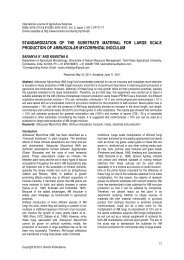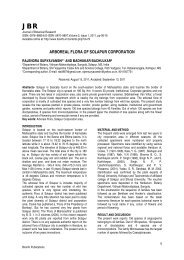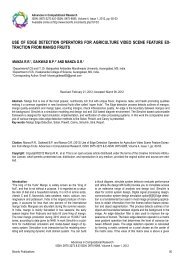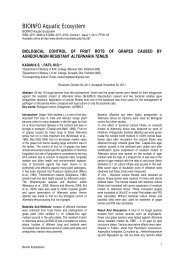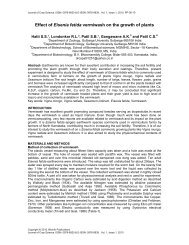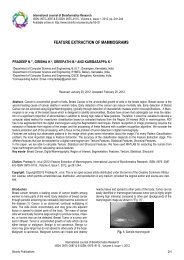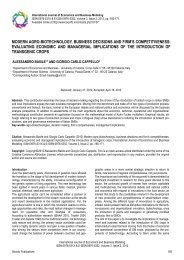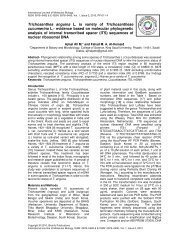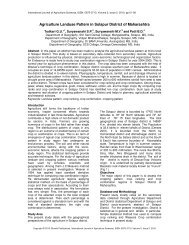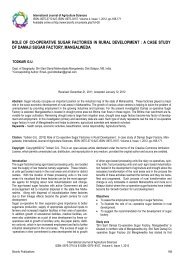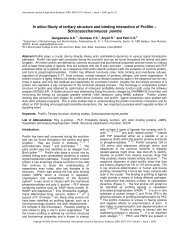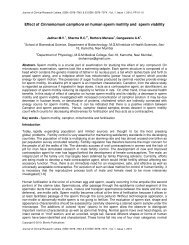Role of bioinformatics in agriculture and sustainable development
Role of bioinformatics in agriculture and sustainable development
Role of bioinformatics in agriculture and sustainable development
You also want an ePaper? Increase the reach of your titles
YUMPU automatically turns print PDFs into web optimized ePapers that Google loves.
allows for the temporal regulation <strong>of</strong> gene expression<br />
through the sequestration <strong>of</strong> the RNA <strong>in</strong> the nucleus, <strong>and</strong><br />
allows for selective transport <strong>of</strong> RNAs to the cytoplasm,<br />
where the ribosomes reside.<br />
Among eukaryotes, the core promoter <strong>of</strong> prote<strong>in</strong>encod<strong>in</strong>g<br />
gene conta<strong>in</strong>s b<strong>in</strong>d<strong>in</strong>g sites for the basal<br />
transcription complex <strong>and</strong> RNA polymerase II, <strong>and</strong> is<br />
normally with<strong>in</strong> about 50 bases upstream <strong>of</strong> the<br />
transcription <strong>in</strong>itiation site. Further transcriptional<br />
regulation is provided by upstream control elements<br />
(UCEs), usually present with<strong>in</strong> about 200 bases<br />
upstream <strong>of</strong> the <strong>in</strong>itiation site [22]. The core promoter for<br />
Pol II sometimes conta<strong>in</strong>s a TATA box, the highly<br />
conserved DNA recognition sequence for the TATA box<br />
b<strong>in</strong>d<strong>in</strong>g prote<strong>in</strong> (TBP) whose b<strong>in</strong>d<strong>in</strong>g <strong>in</strong>itiates<br />
transcription complex assembly at the promoter [23, 18].<br />
Some genes also have enhancer elements that can be<br />
thous<strong>and</strong>s <strong>of</strong> bases upstream or downstream <strong>of</strong> the<br />
transcription <strong>in</strong>itiation site [41]. Comb<strong>in</strong>ations <strong>of</strong> these<br />
upstream control elements <strong>and</strong> enhancers regulate <strong>and</strong><br />
amplify the formation <strong>of</strong> the basal transcription complex.<br />
The transcription <strong>of</strong> a gene can be regulated by cisact<strong>in</strong>g<br />
elements with<strong>in</strong> the regulatory regions <strong>of</strong> the DNA,<br />
<strong>and</strong> trans-act<strong>in</strong>g factors that <strong>in</strong>clude transcription factors<br />
<strong>and</strong> the basal transcription complex.<br />
FUTURE PROSPECTS<br />
Harness<strong>in</strong>g the plant- pathogen genomics<br />
Organisms that cause <strong>in</strong>fectious disease <strong>in</strong>clude fungi,<br />
oomycetes, bacteria, viruses, viroids, virus-like<br />
organisms, phytoplasmas, protozoa, nematodes <strong>and</strong><br />
parasitic plants [42]. Plant pathology <strong>in</strong>volves the study<br />
<strong>of</strong> pathogen identification, disease etiology, disease<br />
cycles, economic impact, plant disease epidemiology,<br />
plant disease resistance, how plant diseases affect<br />
humans <strong>and</strong> animals, pathosystem genetics, <strong>and</strong><br />
management <strong>of</strong> plant diseases. Genome sequenced<br />
from fungi, oomycetes, bacteria, viruses, viroids, viruslike<br />
organisms, phytoplasmas, protozoa, nematodes <strong>and</strong><br />
parasitic plants gives opportunities to underst<strong>and</strong> plant-<br />
pathogen <strong>in</strong>teraction which helps to management,<br />
diagnose the disease <strong>and</strong> make disease resistance<br />
transgenic plant [43]. In its most simple form, the genefor-gene<br />
hypothesis states that plants conta<strong>in</strong> s<strong>in</strong>gle<br />
dom<strong>in</strong>ant resistance R genes that specifically recognize<br />
pathogens that conta<strong>in</strong> complementary avirulence<br />
genes. Avirulence genes can be def<strong>in</strong>ed as genes <strong>in</strong> the<br />
pathogen that encode a prote<strong>in</strong> product that is<br />
conditionally recognized directly or <strong>in</strong>directly only by<br />
those plants that conta<strong>in</strong> the complementary R gene.<br />
To survive, plants must defend themselves<br />
from numerous pathogens. Some defenses are<br />
constitutive, such as various pre-formed anti-microbial<br />
compounds, whereas others are activated by pathogen<br />
recognition. The recognition process <strong>in</strong>cludes the<br />
product <strong>of</strong> a dom<strong>in</strong>ant or semi-dom<strong>in</strong>ant resistance R<br />
gene present <strong>in</strong> the plant <strong>and</strong> the correspond<strong>in</strong>g<br />
dom<strong>in</strong>ant avirulence (Avr) factor encoded by or derived<br />
from the pathogen. The recognition <strong>of</strong> the Avr factor by<br />
the host plant starts one or more signal transduction<br />
<strong>Role</strong> <strong>of</strong> <strong>bio<strong>in</strong>formatics</strong> <strong>in</strong> <strong>agriculture</strong> <strong>and</strong> susta<strong>in</strong>able <strong>development</strong><br />
International Journal <strong>of</strong> Bio<strong>in</strong>formatics Research<br />
ISSN: 0975–3087, E-ISSN: 0975–9115, Vol. 3, Issue 2, 2011<br />
pathways that activate several <strong>of</strong> the plant’s defenses,<br />
thus compromis<strong>in</strong>g the ability <strong>of</strong> the pathogen to colonize<br />
the plant. The <strong>in</strong>teractions between plants <strong>and</strong><br />
pathogens are specific, complex <strong>and</strong> dynamic [44]. The<br />
identification <strong>of</strong> resistant genes <strong>in</strong> the germplasm <strong>of</strong> wild<br />
species <strong>of</strong> field crops <strong>and</strong> their subsequent <strong>in</strong>trogression<br />
<strong>in</strong>to commercial cultivars has been the ma<strong>in</strong> approach <strong>of</strong><br />
many plant breeders. Several strategies for the<br />
identification, characterization <strong>and</strong> functional analysis <strong>of</strong><br />
plant genes <strong>in</strong>volved <strong>in</strong> the trigger<strong>in</strong>g, signal<strong>in</strong>g <strong>and</strong><br />
response to biotic <strong>and</strong> abiotic factors have been recently<br />
envisaged. In-silico biology plays an important role to<br />
underst<strong>and</strong> the plant pathogen <strong>in</strong>teraction at gene <strong>and</strong><br />
genome <strong>of</strong> plants <strong>and</strong> pathogens [45].<br />
References<br />
[1] Untergasser A., Nijveen H., Rao X., Bissel<strong>in</strong>g<br />
T., Geurts R. <strong>and</strong> Leunissen J.A.M. (2007)<br />
Nucleic Acids Research, 35, W71-W74.<br />
[2] Kumari N., S<strong>in</strong>gh V.K., Narayan O.P., Rai L.C.<br />
(2011) Onl<strong>in</strong>e Journal <strong>of</strong> Bio<strong>in</strong>formatics, 12,<br />
289-303.<br />
[3] Mahalakshmi V. <strong>and</strong> Ortiz R. (2001) Electronic<br />
Journal <strong>of</strong> Biotechnology, 3.<br />
[4] Matthews D.E., Carollo V.L., Lazo G.R. <strong>and</strong><br />
Anderson O.D. (2003). Nucleic Acids<br />
Research, 31, 183-186.<br />
[5] Caetano-Anolles. (2005) Crop Science, 45,<br />
1809-1816.<br />
[6] Jaiswal P., Ni J., Yap I., Ware D., Spooner W.,<br />
Youens-Clark K., Ren L., Liang C., Zhao W.,<br />
Ratnapu K., Faga B., Canaran P., Fogleman<br />
M., Hebbard C., Avraham S., Schmidt S.,<br />
Casstevens T.M., Buckler E.S., Ste<strong>in</strong> L. <strong>and</strong><br />
McCouch S. (2006) Nucleic Acids Research,<br />
34, D717-D723.<br />
[7] Paterson A.H., Freel<strong>in</strong>g M. <strong>and</strong> Sasaki, T.<br />
(2005) Genome Research, 15, 1643-1650.<br />
[8] Varshney R.K., Hois<strong>in</strong>gton A.D. <strong>and</strong> Tyagi K.A.<br />
(2006) Trends <strong>in</strong> Biotechnology, 24, 1-10.<br />
[9] Angellotti M.C., Bhuiyan S.B., Chen G. <strong>and</strong><br />
Wan Xiu-Feng (2007) Nucleic Acids Research,<br />
35, W132-W136.<br />
[10] Kale U.K., Bhosle S.G., Manjari G.S., Joshi M.,<br />
Bansode S. <strong>and</strong> Kolaskar A.S. (2006) BMC<br />
Bio<strong>in</strong>formatics, S12-S27.<br />
[11] Tsuru T. <strong>and</strong> Kobayashi I. (2008 Molecular<br />
Biology Evolution, 25, 2457-2473.<br />
[12] H<strong>and</strong>elsman J. (2004) Microbiology <strong>and</strong><br />
Molecular Biology Reviews, 68, 669-685.<br />
[13] Cory J.S. <strong>and</strong> Hoover K. (2006) Trends <strong>in</strong><br />
Ecology <strong>and</strong> Evolution, 21, 278-286.<br />
[14] Kummerfeld S.K. <strong>and</strong> Teichmann S.A. (2006)<br />
Nucleic Acids Research, 34, D74-–D81.<br />
[15] P<strong>and</strong>ey S.P. <strong>and</strong> Somssich I.E. (2009) Plant<br />
Physiology, 150, 1648-1655.<br />
[16] Todd J. Vision <strong>and</strong> Aoife McLysaght (2003)<br />
H<strong>and</strong>book <strong>of</strong> Plant Biotechnology (Ed. Paul<br />
Christou <strong>and</strong> Harry Klee). John Wiley <strong>and</strong><br />
Sons Ltd.<br />
224



